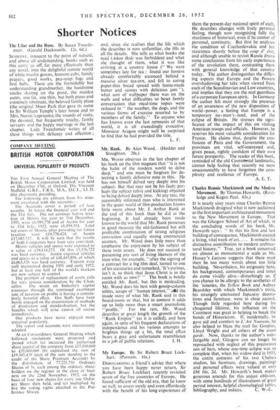IT is nearly sixty years since Charles Rennie Mackintosh designed
what is now acclaimed as the first important architectural monument to the New Movement in Europe. That was the Glasgow School of Art of which, in the concluding words of his book, Mr. Howarth says : " In this his first and last building of consequence, Mackintosh created a living, vital work of art.... It remains his distinctive contribution to modern architec- tural history." True, yet a book conceived on almost as monumental a scale as Mr. Hussey's Lutyens suggests that there must then be too many words about too little building. Nevertheless, his enigmatic hero, his background, contemporaries and times do come vividly alive—disturbingly so, if you chance to be allergic to the aesthetics of the 'nineties, the Yellow Book and Aubrey Beardsley with which Mackintosh's trivia, his strangely attenuated Japanesy decora- tions and furniture, were in close accord. Though little regarded here during his chequered lifetime, his influence on the Continent was great in helping to break the bonds of Historicism. If, incidentally, he gave aid and comfort to L' Art Nouveau, he also helped to blaze the trail for Gropius, Lloyd Wright and all others of the avant garde. Now, thanks to the author's inde- fatigable zeal, Glasgow can no longer be reproached with neglect of this precocious son of hers, whose one-time eclipse was so complete that, when his widow died in 1933, the entire contents of his two Chelsea studios, his furniture, drawings, paintings and personal effects were valued at only £88 16s. 2d. Mr. Howarth's book makes generous amends for this unjust oblivion, with some hunareds of illustrations of great period interest, helpful chronological tables, bibliography, and indices. C. W.-E.


























 Previous page
Previous page